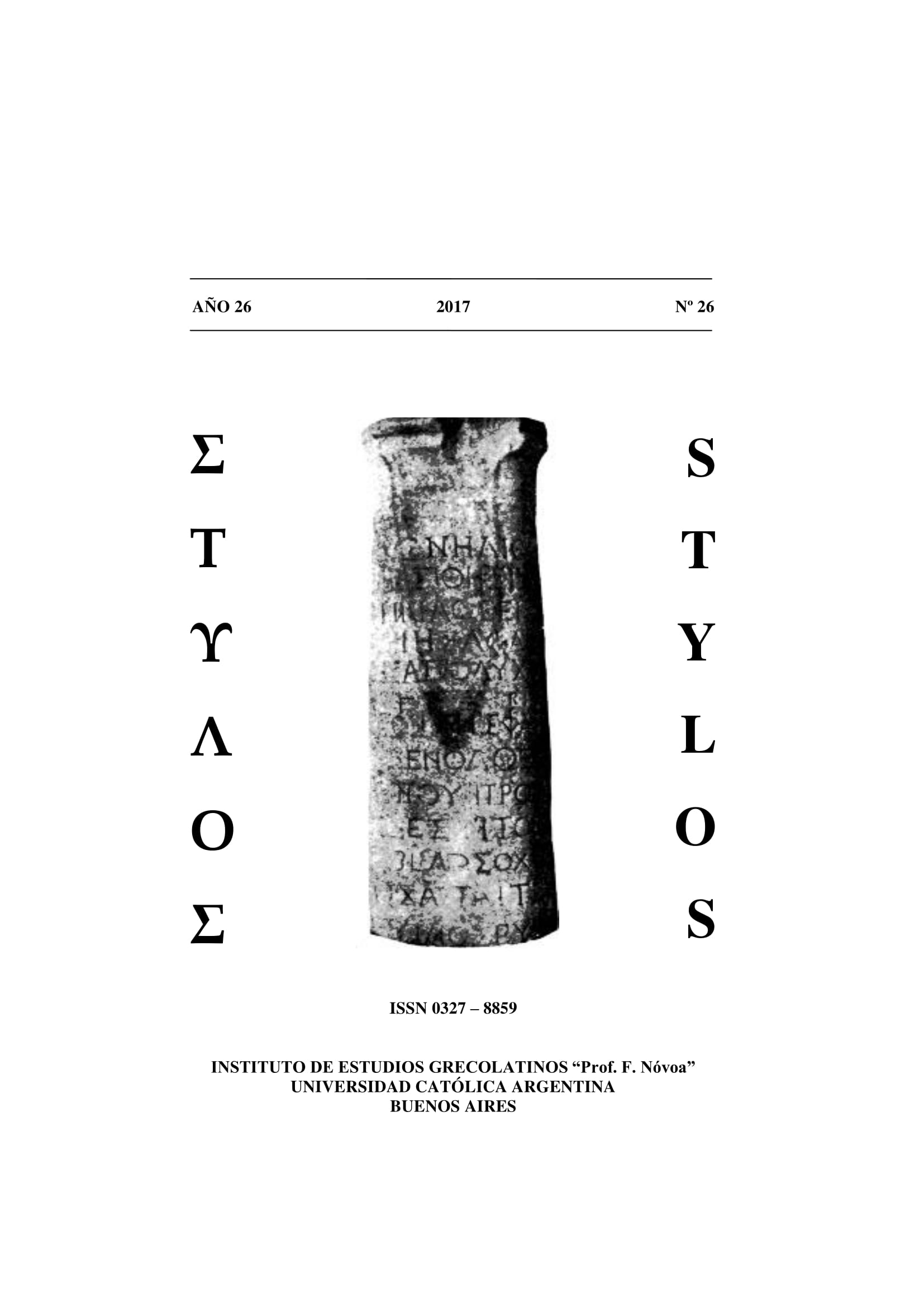OVIDIO Y CICERÓN: INFLUENCIA DE CICERÓN EN LA OBRA DE OVIDIO
Keywords:
Cicero – Metamorphoses – Fasti – apotheosis – sphragis – unus homo.Abstract
The purpose in this paper is to find out, seeking in the allusion and the style, Cicero's influence on Ovid's longest works, an influence which have been briefly suggested, in the case of the Metamorphoses, by Hardie and Gildenhard and Zissos. While the Ovid's type of link is, as we shall see, a literary one, we will realize that political definitions, even in an allegedly apolitical author, are also involved. The discussion will consider, especially in the Metamorphoses but also in the Fasti, Cicero’s influence in the creation of man, the apotheosis motif, the proem and the sphragis, as well as in the Ovidian representation of the unus homo and the eulogy of monarchy, with its Augustan associations.Downloads
References
ALTON, E. H.- WORMELL, D. E. W.- COURTNEY, E. (2005), P. Ovidius Naso Fastorum libri sex, Múnich-Leipzig.
BARCHIESI, A. (1994), Il poeta e il principe. Ovidio e il discorso augusteo, Roma-Bari.
BÖMER, F. (1969), P. Ovidius Naso, Metamorphosen. Kommentar (I-III), Heidelberg.
BUISEL, M. D. (1999), “Discurso mítico y discurso histórico en la IV égloga de Virgilio”, Auster 4, 41-62.
BUISEL, M. D. (2013), “Magistraturas e imperium: de la monarquía al principado”, Circe 17, 31-44.
CAMPBELL, B. (2011), Historia de Roma. Desde los orígenes hasta la caída del imperio, Barcelona (trad. J. Alquézar).
DENCH, E. (2013), “Cicero and Roman Identity”, en Steel, C. (ed.), The Cambridge Companion to Cicero, Cambridge, 122-140.
ERNOUT, A. Y F. THOMAS (1964), Syntaxe latine, París (2ª edición).
EVERITT, A. (2007), Cicerón, Barcelona (trad. A Morales).
FEENEY, D. (2015), “Ovid’s Ciceronian Literary History: End-career Chronology and Autobiography”, Sixth UCL Housman Lecture, Pamphlet published by Department of Greek and Latin, University College , Londres, 19 pp.
FONTAINE, J. (1982), “Un cliché de la spiritualité antique tardive: stetit immobilis”, en Romanitas-Christianitas. Untersuchungen zur Geschichte und Literatur der römischen Kaiserzeit, Berlín -Nueva York, 528-552.
FRANCOIS, G. (1976), Grammaire latine, Lieja.
GALINSKY, K. (1967), “The Cipus Episode in Ovid's Metamorphoses (15.565-621)”, TAPhA 98, 181-191.
GALINSKY, K. (1972), The Herakles Theme. The Adaption of the Hero in Literature from Homer to the Twentieth Century, Oxford.
GALINSKY. K. (1996), Augustan Culture. An Interpretive Introduction, Princeton.
GILDENHARD, I. -ZISSOS, A. (2004), “Ovid’s Hecale: Deconstructing Athens in the Metamorphoses”, JRS 94, 47–72.
GOSLING, A. (2002), “Sending up the Founder: Ovid and the Apotheosis of Romulus”, AClass 45, 51-69.
GOWING, A. (2013), “Tully’s Boat: Responses to Cicero in the Imperial Period”, en Steel, C. (ed.), The Cambridge Companion to Cicero, Cambridge, 233-250.
GRANOBS, R. (1997), Studien zur Darstellung römischer Geschichte in Ovids ‘Metamorphosen’, Frankfurt.
HARDIE, P. (2002), “The Historian in Ovid: The ‘Roman History’ of Met. 14-15”, en Levene D. S.- Nelis, D. P. (eds.), Clio and the Poets: Augustan Poetry and the Traditions of Ancient Historiography, Leiden, 191-210.
HARDIE, P. (2015), Ovidio. Metamorfosi, Volume VI (libri XIII-XV), Mi-lán.
LITTLEWOOD, R. S. (2002), “Imperii pignora certa: the Role of Numa in Ovid’s Fasti”, en Herbert-Brown, G. (ed.), Ovid’s Fasti. Historical Readings at its Bimillenium, Oxford, 175-197.
LOWRIE, M. (2007), “Making an Example of Yourself: Cicero and Augustus”, en Heyworth, S. J., -Fowler, P. G. –Harrison, S. J. (eds.), Classical Constructions. Papers in Memory of Don Fowler, Classicist and Epicurean, Oxford, 91-112.
LUNDSTRÖM, S. (1980), Ovids Metamorphosen und die Politik des Kaisers, Upsala.
MARKS, R. (2004), “Of Kings, Crowns, and Boundary Stones: Cipus and the hasta Romuli in Metamorphoses 15”, TAPhA 134, 197-131.
MARTÍNEZ ASTORINO, P. (2013), “Reseña de Myers, K. S., Ovid’s Meta-morphoses (Book XIV)”, Auster 18, 122-124.
MARTÍNEZ ASTORINO, P. (2017), La apoteosis en las Metamorfosis de Ovidio: diseño estructural, mitologización y “lectura” en la representación de apoteosis y sus contextos, Bahía Blanca.
MARTÍNEZ ASTORINO, P. (2017b), “Cipo-César en las Metamorfosis de Ovidio: ¿una reivindicación de la monarquía?”, Euphrosyne 45.
MYERS, K. S. (2009), Ovid Metamorphoses, Book XIV, Cambridge.
NISBET, R. G. M. & RUDD, N. (2004), A Commentary on Horace: Odes. Book III, Oxford.
PEASE, A. S. (1958), M. Tulli Ciceronis De Natura Deorum Libri Secun-dus et Tertius, Cambridge.
PETERSMANN, M. (1976), Die Apotheosen in den “Metamorphosen” Ovids, Graz. Tesis doctoral.
PORTE, D. (1985), “L’idée romaine et la métamorphose”, en Frécaut, J-M. & Porte, D., Journées ovidiennes de Parménie: actes du Colloque sur Ovide, 24-26 juin 1983, Bruselas, 175-198.
RUBIO, L. (1982), Introducción a la sintaxis estructural del latín, Barcelona.
SALZMAN, M. (1998), “Deification in the Fasti and the Metamorphoses”, en Deroux, C. (ed.), Studies in Latin Literature and Roman History IX, Collection Latomus 244, Bruselas, 313-346.
SCHMIDT, E. A. (1991l), Ovids poetische Menschenwelt. Die Metamor-phosen als Metapher und Symphonie, Heidelberg.
SCHMITZER, U. (1990), Zeitgeschichte in Ovids Metamorphosen. Mythologische Dichtung unter politischem Anspruch, Stuttgart.
TARRANT, R. J. (2004), P. Ovidi Nasonis Metamorphoses, Oxford.
WEINSTOCK, S. (1971), Divus Iulius, Oxford.
WHEELER, S. (2000), Narrative Dynamics in Ovid’s Metamorphoses, Tü-bingen.
WICKKISER, L. B. (1999), “Famous last Words: Putting Ovid’s Sphragis Back into the Metamorphoses”, MD 42, 113-142.
ZETZEL, J. E. G. (2013), “Political Philosophy”, en Steel, C. (ed.), The Cambridge Companion to Cicero, Cambridge, 181-195.
Downloads
Published
How to Cite
Issue
Section
License






